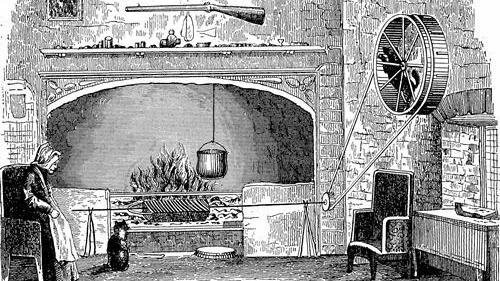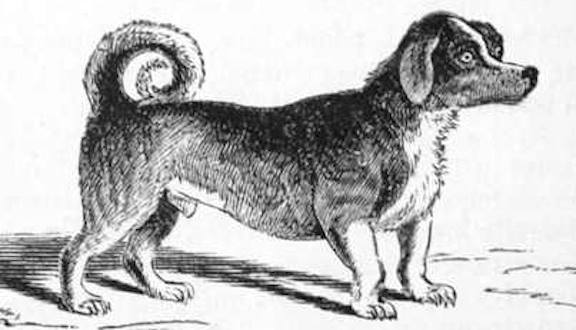Welsh Corgi history
The 16th Century ‘Turnspit’ Kitchen Dog

By Ken Zurski
The history of working dogs go way back, centuries in fact to the age of the Vikings, who used the strong, stout breeds for hunting and herding cattle. Some of these breeds, including the Nork or Norwegian Elkhound, remain viable even today.
But perhaps no other breed better exemplifies the skill and resiliency of a working dog more than the turnspit, or kitchen dog, whose job it was to turn the spit and cook the meat over a roasting fire.
This was accomplished by a wooden wheel that was mounted on the wall and connected by ropes to the spit in front of the fireplace. The dog would be hoisted on the wheel and begin to run, similar to a hamster in a cage. As the dog ran, the wheel spun, the spit turned, and the meat cooked evenly. To keep the dog from overheating or fainting, the wheel was placed just far enough away from the heat and sparks. And when a dog tired another dog would be ready to take its place.

Until the 16th century when turnspit dogs were introduced, the turning of the cooking spit was the responsibility of a lowest ranking family member, usually the youngest child and almost always a boy. The job was grueling and often resulted in burns, blisters, sores or worse. Dogs were just a better option. Plus they could work longer and would ask for nothing more than to be fed.
Descriptions vary a bit but the overall picture of a “turnspit” paints a dog with short or crooked legs, a heavy head, and dropping ears.

They were low-bodied, strong, sturdy and as one dog historian notes, endured cruel punishment. To train the dog to run faster, oftentimes a burning coal was thrown into the wheel.
In 1750, turnspits were reportedly everywhere in Great Britain. (There are only a few instances that show them in America.) A century later, in 1850, the turnspit breed was nearly gone. The availability of cheaper spit-turning machines, called clock jacks, replaced the turnspits. And since the dogs were considered unappealing and mostly unfriendly, no one kept them as pets. Today the extinct breed is compared to a Welsh Corgi, although its similarities are in looks only.
According to sources, the turnspit dogs would get one day off from the wheel: Sunday.
Not for any spiritual connotation, mind you, but for another useful purpose.
They made good foot warmers in drafty church pews.

“Whiskey,” a taxidermied turnspit dog on display at the Abergavenny Museum in Wales.
